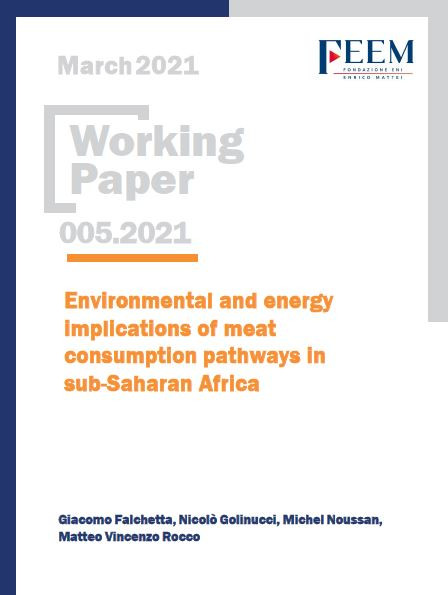Environmental and energy implications of meat consumption pathways in sub-Saharan Africa

03.03.2021
Giacomo Falchetta (Fondazione Eni Enrico Mattei, Free University of Bozen-Bolzano); Nicolò Golinucci (Fondazione Eni Enrico Mattei, Politecnico di Milano); Michel Noussan (Fondazione Eni Enrico Mattei); Matteo Vincenzo Rocco (Politecnico di Milano)
O13, Q01, Q21, Q56
Meat Consumption, Economic Development, Environmental Impact Assessment, Environmentally Extended Input-output Analysis, Sub-Saharan Africa
In sub-Saharan Africa (SSA) diets are largely based on cereal or root staple crops. Together with socio-cultural change, economic and demographic growth could boost the demand for meat, with significant environmental repercussions. We model meat consumption pathways to 2050 for SSA based on several scenarios calibrated on historical demand drivers. To assess the consequent environmental impact, we adopt an environmentally-extended input-output (EEIO) framework and apply it on the EXIOBASE 3.3 hybrid tables. We find that, depending on the interplay of resources efficiency and demand growth, by 2050 global greenhouse gases emissions could grow by 1.4 [0.9-1.9] Gt CO2e/yr (~175% of current regional agriculture-related emissions), cropping and grazing-related land may cover additional 15 [12.5-21] · 106 km2 (one quarter of today’s global agricultural land), blue water consumption could rise by 36 [29-47] Gm3 /yr (nearly doubling the current regional agricultural consumption), the eutrophication potential could grow by 7.6 [4.9-9.5] t PO4e/yr and additional 0.9 [0.5-1.4] EJ/yr of fossil fuels and 49 [32-73] TWh/yr of electricity may be consumed. These results suggest that – in the absence of drastic resource efficiency or technological improvements – meat demand in SSA is bound to become a major sustainability challenge. We show that a partial substitution of the protein intake with plant-based alternatives carries significant potential for mitigating these impacts. The policies affecting farming practices and dietary choices will thus have a significant impact on regional and global environmental flows.
***
Suggested citation: G. Falchetta, N. Golinucci, M. Noussan, M. V. Rocco, (2021), ‘Environmental and energy implications of meat consumption pathways in sub-Saharan Africa’, Nota di Lavoro 5.2021, Milano, Italy: Fondazione Eni Enrico Mattei
